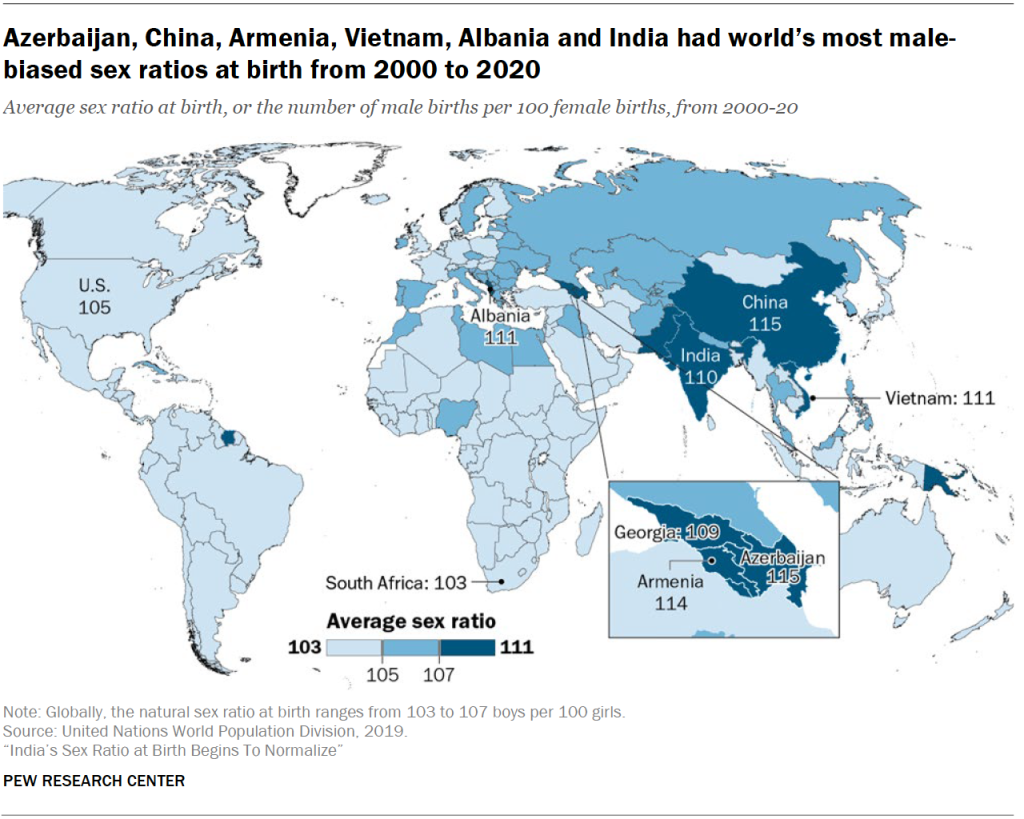At any given time, there are almost as many women as men in the world – the typical balance is around 101 males per 100 females, according to the United Nations. At birth, without any human intervention, boys slightly outnumber girls, at a rate of around 105 boys per 100 girls, with male births ranging from 103 to 107 per 100 girls in most countries.
But females catch up over time, because males are more likely to succumb to disease during childhood or to die young in adulthood from smoking or other unhealthy and risky behaviors. Globally, women outlive men by an average of five years, and among older cohorts, women vastly outnumber men. Among people in the U.S. ages 85 and older, for example, there were only 56 males per 100 females in 2020, according to the most recent census.
In some countries, sex ratios are in the natural range at birth but become lopsided among adults for reasons other than men’s shorter life expectancy. Migration often explains this phenomenon. In Ukraine, for example, there were only 86 males per 100 females in 2020, because so many young men had left to work in neighboring European Union countries. Now, this situation is reversing: Russia’s invasion has led to an exodus of nearly 6.0 million (0.6 crore) Ukrainians, predominantly women and children. Men ages 18 to 60 are barred from leaving the country.

In other places, largely in South Asia and East Asia, a widespread preference for sons, coupled with sex-selective abortions, is the cause of unnatural sex ratios at birth. Some scholars have noted that countries with heavy imbalances generally meet three preconditions: a widespread desire for sons and/or aversion to daughters; parents seeking to have smaller families; and the availability of prenatal sex detection (typically, ultrasound technology) and abortion services.11
An analysis of 2000-20 birth data from the UN shows that over these two decades, China and Azerbaijan had the most skewed sex ratios at birth, with an annual average of around 115 boys per 100 girls. In China, the government’s decades-long enforcement of a one-child policy starting in 1980 and the spread of ultrasound technology led to a sharp increase in sex-selective abortions at the end of the last century. In Azerbaijan, as well as in the neighboring former Soviet republics of Armenia (114) and Georgia (109), sex ratios at birth were not skewed toward boys until the 1990s. Some scholars blame the economic turmoil that followed the collapse of the Soviet Union, which they say drove couples to have fewer children but increased the need for sons who could support aging parents as government benefits shrank.12
In Vietnam, where abortion has been legal since the 1960s, the sex ratio at birth was balanced until the early 2000s, when ultrasound services started to spread. Similarly, Albania’s sex ratio became skewed toward boys in the 1990s, following the legalization of abortion and widening access to ultrasound technology. From 2000 to 2020, Vietnam and Albania had the world’s fourth- and fifth-widest average annual sex ratio at birth (111 each).
Over the same two-decade period, India was near the top of the global list, with an average sex ratio at birth of around 110.
In countries where males heavily outnumber females at birth, the childhood mortality rate for girls also tends to be high, either because girls are being killed soon after birth, or because they are neglected – intentionally or unintentionally – by their parents during childhood.13
Worldwide, an estimated 142.6 million (14.3 crore) females went “missing” between 1970 and 2020, due to sex-selective abortion or to neglect, according to a 2020 UN report. China (51%) and India (32%) accounted for most of these “missing” females. (In this context, “missing” females refers to an estimate of how many more females, including girls and women of all ages, there would be if there were no sex-selective abortions, mistreatment or neglect of females.)




